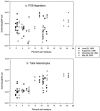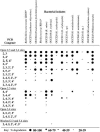Polychlorinated biphenyl (PCB)-degrading bacteria associated with trees in a PCB-contaminated site
- PMID: 16597927
- PMCID: PMC1449058
- DOI: 10.1128/AEM.72.4.2331-2342.2006
Polychlorinated biphenyl (PCB)-degrading bacteria associated with trees in a PCB-contaminated site
Abstract
The abundance, identities, and degradation abilities of indigenous polychlorinated biphenyl (PCB)-degrading bacteria associated with five species of mature trees growing naturally in a contaminated site were investigated to identify plants that enhance the microbial PCB degradation potential in soil. Culturable PCB degraders were associated with every plant species examined in both the rhizosphere and root zone, which was defined as the bulk soil in which the plant was rooted. Significantly higher numbers of PCB degraders (2.7- to 56.7-fold-higher means) were detected in the root zones of Austrian pine (Pinus nigra) and goat willow (Salix caprea) than in the root zones of other plants or non-root-containing soil in certain seasons and at certain soil depths. The majority of culturable PCB degraders throughout the site and the majority of culturable PCB degraders associated with plants were identified as members of the genus Rhodococcus by 16S rRNA gene sequence analysis. Other taxa of PCB-degrading bacteria included members of the genera Luteibacter and Williamsia, which have not previously been shown to include PCB degraders. PCB degradation assays revealed that some isolates from the site have broad congener specificities; these isolates included one Rhodococcus strain that exhibited degradation abilities similar to those of Burkholderia xenovorans LB400. Isolates with broad congener specificity were widespread at the site, including in the biostimulated root zone of willow. The apparent association of certain plant species with increased abundance of indigenous PCB degraders, including organisms with outstanding degradation abilities, throughout the root zone supports the notion that biostimulation through rhizoremediation is a promising strategy for enhancing PCB degradation in situ.
Figures



Similar articles
-
Biphenyl-utilizing bacteria and their functional genes in a pine root zone contaminated with polychlorinated biphenyls (PCBs).ISME J. 2007 Jun;1(2):134-48. doi: 10.1038/ismej.2007.26. Epub 2007 May 24. ISME J. 2007. PMID: 18043623
-
Novel PCB-degrading Rhodococcus strains able to promote plant growth for assisted rhizoremediation of historically polluted soils.PLoS One. 2019 Aug 22;14(8):e0221253. doi: 10.1371/journal.pone.0221253. eCollection 2019. PLoS One. 2019. PMID: 31437185 Free PMC article.
-
Phyto/rhizoremediation studies using long-term PCB-contaminated soil.Environ Sci Pollut Res Int. 2009 Nov;16(7):817-29. doi: 10.1007/s11356-009-0240-3. Environ Sci Pollut Res Int. 2009. PMID: 19823887
-
Prospects for using combined engineered bacterial enzymes and plant systems to rhizoremediate polychlorinated biphenyls.Environ Microbiol. 2013 Mar;15(3):907-15. doi: 10.1111/1462-2920.12007. Epub 2012 Oct 26. Environ Microbiol. 2013. PMID: 23106850 Review.
-
Revealing potential functions of VBNC bacteria in polycyclic aromatic hydrocarbons biodegradation.Lett Appl Microbiol. 2018 Apr;66(4):277-283. doi: 10.1111/lam.12853. Epub 2018 Feb 26. Lett Appl Microbiol. 2018. PMID: 29350767 Review.
Cited by
-
Remedial effects of Potamogeton crispus L. on PAH-contaminated sediments.Environ Sci Pollut Res Int. 2015 May;22(10):7547-56. doi: 10.1007/s11356-015-4280-6. Epub 2015 Mar 11. Environ Sci Pollut Res Int. 2015. PMID: 25752637
-
Salix purpurea Stimulates the Expression of Specific Bacterial Xenobiotic Degradation Genes in a Soil Contaminated with Hydrocarbons.PLoS One. 2015 Jul 10;10(7):e0132062. doi: 10.1371/journal.pone.0132062. eCollection 2015. PLoS One. 2015. PMID: 26161539 Free PMC article.
-
Developing microbe-plant interactions for applications in plant-growth promotion and disease control, production of useful compounds, remediation and carbon sequestration.Microb Biotechnol. 2009 Jul;2(4):428-40. doi: 10.1111/j.1751-7915.2009.00109.x. Epub 2009 Apr 23. Microb Biotechnol. 2009. PMID: 21255275 Free PMC article. Review.
-
The formation and fate of chlorinated organic substances in temperate and boreal forest soils.Environ Sci Pollut Res Int. 2009 Mar;16(2):127-43. doi: 10.1007/s11356-008-0090-4. Epub 2008 Dec 23. Environ Sci Pollut Res Int. 2009. PMID: 19104865 Review.
-
Plants Rather than Mineral Fertilization Shape Microbial Community Structure and Functional Potential in Legacy Contaminated Soil.Front Microbiol. 2016 Jun 24;7:995. doi: 10.3389/fmicb.2016.00995. eCollection 2016. Front Microbiol. 2016. PMID: 27446035 Free PMC article.
References
-
- Bardyshev, I. I., G. Ya, and R. I. Zen'ko. 1970. Properties and chemical composition of colophony and turpentine produced from Bulgarian oleoresin from Pinus sylvestris and Pinus nigra. Biologiya 8:113-120.
-
- Barry, C. E. I., R. E. Lee, K. Mdluli, A. E. Sampson, B. G. Schroeder, R. A. Slayden, and Y. Yuan. 1998. Mycolic acids: structure, biosynthesis and physiological functions. Prog. Lipid Res. 37:143-179. - PubMed
-
- Bedard, D. L., and M. L. Haberl. 1990. Influence of chlorine substitution pattern on the degradation of polychlorinated biphenyls by eight bacterial strains. Microb. Ecol. 20:87-102. - PubMed
-
- Belimov, A. A., V. I. Sfronova, T. A. Sergeyeva, T. N. Egorova, V. A. Matveyeva, V. E. Tsyganov, A. Y. Borisov, I. A. Tikhonovich, C. Kluge, A. Preisfeld, K.-J. Dietz, and V. V. Stepanok. 2001. Characterization of plant growth promoting rhizobacteria isolated from polluted soils and containing 1-aminocyclopropane-1-carboxylate deaminase. Can. J. Microbiol. 47:642-652. - PubMed
Publication types
MeSH terms
Substances
Associated data
- Actions
- Actions
- Actions
- Actions
- Actions
- Actions
- Actions
- Actions
- Actions
- Actions
- Actions
- Actions
- Actions
- Actions
- Actions
- Actions
- Actions
- Actions
- Actions
- Actions
- Actions
- Actions
LinkOut - more resources
Full Text Sources
Other Literature Sources
Molecular Biology Databases

